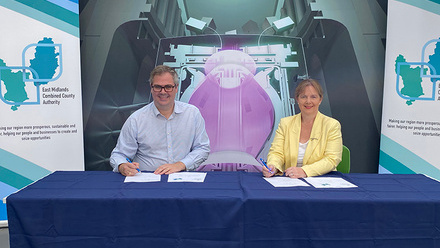The importance of design and sealing in EV battery boxes
Izaak Watson CSci MIMMM, IOM3 Rubber in Engineering Committee member and Technical Manager at Martins Rubber gives an oversight on the electric vehicle market and battery box design.

The global electric air taxi market is predicted to be worth over US$6bln by 2030, with piloted air taxis and shuttle services expected to be a reality by 2025. This is no longer the stuff of science fiction – and so, combined with the already extensive electric road car market, high-tech manufacturers find themselves in a race to meet both the stringent safety requirements and the high-performance demands of this evolving transportation industry.
The electric vehicle (EV) market is set to expand considerably leading up to 2030, as vehicle makers seek to avoid fines from exceeding emissions target set out in the European Union’s 2021 CO2 emissions targets. It is expected 25–30% of the total light-vehicle market will be EV by 2024 up from a current 8.5%. The increased demand for EV’s, along with the risk of up to €14.5bn in fines for Europe’s top 13 car makers (Dobson 2020), will drive considerable investment in EV storage and power in the next few years.
Battery packs are at the centre of this development challenge. Ensuring the critical seal around the battery cell meets such exacting demands needs to be an integral part of the design process, not an afterthought. Careful selection of the right materials, and optimised use of material, can provide weight savings. The right seal design, when considered in parallel with the case design, can save production costs through design for manufacturability. A durable seal around the battery case allows a modular design, where individual cells can be replaced if required. This is critical for the economic feasibility of these power units.
What does a battery box do?

The battery box contains the cells that store charge, which power the motor inverters. The box keeps the cells isolated from the environment, stopping the ingress of dust and water which could damage the electronics. Battery cases can offer a structural support for the cells, keeping them secure in the vehicle and in the correct arrangement. Cooling methods can be designed into the battery box, to keep the cells working at an optimum temperature. The battery box should keep the cells contained in the event of a leak or thermal event, ensuring the rest of the vehicle is safe in catastrophic events. The battery box may also need to be a rapidly interchangeable design in swap out applications where the in-service time of the vehicle precludes plug-in charging time.
Battery box design
In terms of composite battery case design, the usual factors concerned with composite design should be considered.
These can include:
- tooled (A) and un-tooled (B) surfaces
- draft angles
- undercut features
- reinforcement areas
- bond gaps and widths
- assembly access
along with several other more specific questions determined by the composite process.
Seal material selection
Several aspects must be considered on selecting the correct material with which to make the battery box seal. These include:
- Oil/fuel resistance
- Air/gas permeability
- Hot air resistance
- Low temperature flexibility
- Material hardness
- Material resiliency and durability
- Stress/strain characteristics
- Environmental resistance (UV/sunlight, ozone etc)
- Flame retardancy
as well as processability to ensure the part can be made in the first place.
Cooling and battery efficiency
The functional design of the case is very much specific on the battery application. The operating temperature range of the battery packs is a key piece of information required during the design and development phase. lithium-ion batteries work between a specific temperature range. Due to the temperature increases seen during operation and charging, cooling of the cells is critical to keep the cells at an optimum temperature. This cooling can be done in several different ways from fluids to air flow and must be carefully designed for effectiveness.
Safety requirements
One of the key things that needs to be considered is significant increase in temperatures seen within the cells during a thermal runaway scenario. In this case the temperatures can increase to significantly higher than 1000°C and the risk of fire is very high.
The safety requirements of the battery cases vary significantly across different industries. In aerospace, for example, one of the key factors is the burn through time. This time is directly related to the time the pilot will have to get the aircraft to the ground.
In this scenario fire, smoke, toxicity (FST) resistant resin systems, such as phenolics, may be chosen. However, phenolics unfortunately do not have the inherent structural performance as other resin systems, and typically have a glass transition temperature (Tg) of lower than 200°C. This is a good indication of the thermal performance of a resin system, above this temperature there will be a decrease in material modulus.
In other industries, where the FST requirements may be a lower priority to structural performance and heat resistance, the use of bio-based resins or cyanate ester would provide a much higher temperature resistance.
The battery box seal must also comply with stringent flammability specifications. The challenge here is a composite case requires a low sealing force, to avoid deflecting the structure between fixings. Flame retardant rubber compositions rely on a high loading of inert, and often dense, filler materials such as silica sand to reduce the combustible polymer content. This results in a higher hardness and heavier material than the ideal. The seal design can ensure optimum sealing at lower closure forces, and material and seal design can help reduce weight.
What is the right level of contact in the seal?
It is important to obtain the correct force required on the fixings to compress the seal in the battery case. If the compressive force is too low the seal may hold the case open, or too high may cause the seal to over compress and split or damage to the carbon composite. It is also important to consider the effect of thermal expansion between the seal and the case, to avoid unwanted displacements.
Working with specialists can help companies meet regulations and to develop and manufacture bespoke sealing solutions. Companies, including Martin’s Rubber, are continuing to proactively invest in developing materials and technologies for sustainable methods of travel, such as electric vehicles.
References
Dobson, J (2020) How do you design a lightweight battery box for an electric vehicle?
www.far-uk.com/index.php/farnews/40-lightweight-batteries [Accessed 28/04/2021]
Izaak Watson CSci MIMMM, IOM3 Rubber in Engineering Committee member and Technical Manager at Martins Rubber







